|
Comfort dogs in the
classroom ease student anxieties
 Send a link to a friend
Send a link to a friend
[March 06, 2025]
When you think about things you would find in a
classroom, you probably imagine things like desks, whiteboards or
chalkboards, pencils, etc. You probably do not imagine a dog in the
classroom. Yet, there are studies to suggest that having therapy
dogs in the classroom is not only important for the students’ mental
and emotional health but can lead to increased learning for the
students.
|
|
According to research by the U.S. Department of
Education, therapy dog visits in the classroom have shown to have
“a) increased reading and language skills, b) social, emotional, and
humane gains, and c) improved gross motor skills.” The increase in
reading skills can be especially true when the students read to the
dogs.
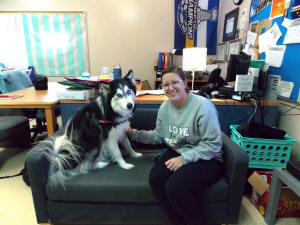
Dr. Amber Jordan with Glacier
Local educator Dr. Amber Jordan, teacher at Lincoln
Junior High School (LJHS), has taken full advantage of this research
in her classroom, getting the district to green light bringing her
own therapy dogs in once per week. LDN was able to sit down with Dr.
Jordan for an interview on why she does this and the impact she has
seen in her class.
Jordan has two Siberian Huskies named Glacier and Frost, and she
brings one of them in each week, usually on Mondays. Jordan got this
idea from one of her past students after they mentioned the idea of
having a class pet, specifically a dog. After this discussion,
Jordan went and got Glacier and Frost their therapy dog
certifications. “I knew it was something that [my students] wanted,”
Jordan said, “and if I could do, then I would.”

When asked about any social-emotional growth in her
students, and if Glacier and Frost have been able to help students
grow in those ways, Jordan’s immediate response was “oh yeah, for
sure.” She shared that she has some students who do not want to be
at school, but as soon as they see either of the therapy dogs, their
faces light up. Jordan also stated that she occasionally has
students who will shut down. “If that student shuts down on a day
that [Glacier or Frost] are here… they come out of it way quicker.”
She also states that she sets a classroom goal for one of her dogs
to come in each week, and she sees a lot of collaboration among her
students to try to reach that goal each week.
Jordan was then asked about any academic improvements since Glacier
and Frost started coming in. While she said that she has not
collected data on any specific academic skills, work completion
overall has shown a significant improvement. Jordan also said that
she tends to have more engagement and participation from her
students when Glacier or Frost are around, specifically in reading.
The next topic Jordan was asked about was her opinion on the best
part of bringing her therapy dogs into the classroom. She shared
that she loves to see the kindness her students try to show her
dogs, and also the impact they have on her students. “If they’re
having something going on at home, or if they have something that is
bothering them here at school, it relieves that stress,” Jordan
said. Jordan also shared that her goal is always to help her
students. Having her dogs around to help her help her students is
something that is really important to her.
Both Glacier and Frost are certified through the
Alliance of Therapy Dogs, and Jordan has to have them recertified
every year. Glacier and Frost also have to volunteer once every
three months to continue their certification as well. Jordan shared
that Glacier and Frost have volunteered at Heartland Community
College and Eastern Illinois University in the past.

Jordan then took a moment to talk about some things
that are important to her regarding therapy dogs. When out in the
community, Jordan has noticed that some people are afraid of Glacier
and Frost, or they are not sure how to interact with them. One of
the added benefits of bringing her dogs into the classroom is
teaching them about how they should approach animals. She enjoys
teaching her students “how you should approach an animal, and you
should not be super excited about things, or how you don’t just go
up to [an animal] and start petting them… especially when it comes
to service animals.” Jordan says that arming her students with this
knowledge is going to help them out in the real world.
Jordan also shared that she has learned a lot about
dog body behavior, and how to tell when Glacier or Frost are
stressed. She has had days where her dogs are communicating that
they do not want to come with her to school that day, and she
listens to them and lets them stay home.
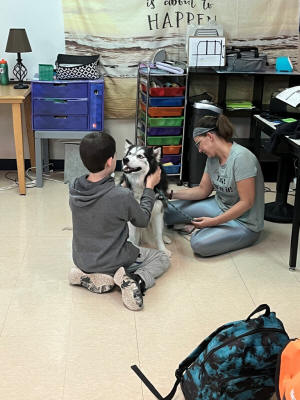
[to top of second column]
 |

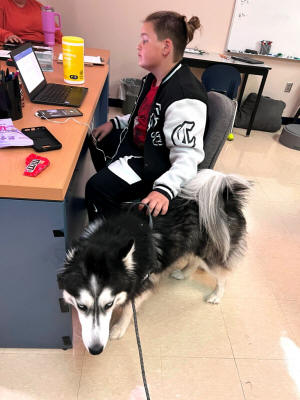
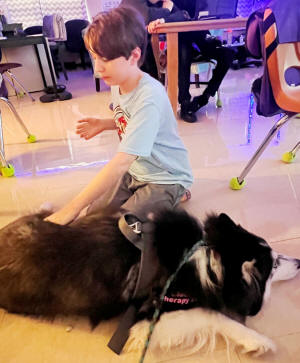
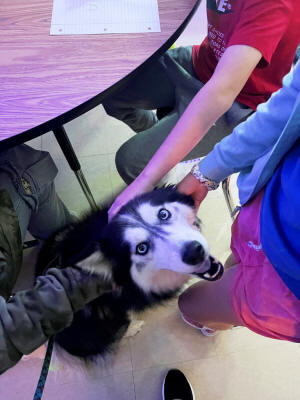
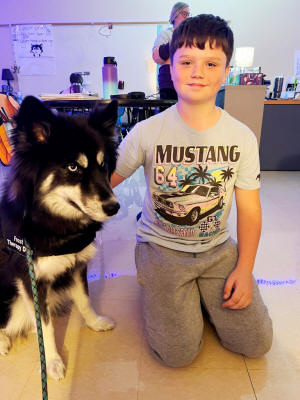

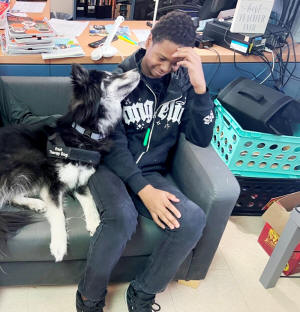
Photos by Dr. Jordan
Jordan also took a moment to talk to
her students about what they like about Glacier and Frost coming
into their classroom.
Here are a few of the things that they had to say:
• “Having Glacier and Frost at school helps to relieve my stress.”
• “They should be able to work in this classroom for a long time so
maybe they can help more kids with being able to control their
anger.”
• “When Glacier and Frost are here, it is easier for me to focus on
my work.”
• “I love doing tricks with the dogs, they put a smile on my face,
and it’s fun to watch them learn new tricks.”
• “Glacier and Frost have helped out class so much that I think all
schools should have a therapy dog.”
[Matt Boutcher]
Sources:
https://files.eric.ed.gov/fulltext/EJ1173578.pdf
|